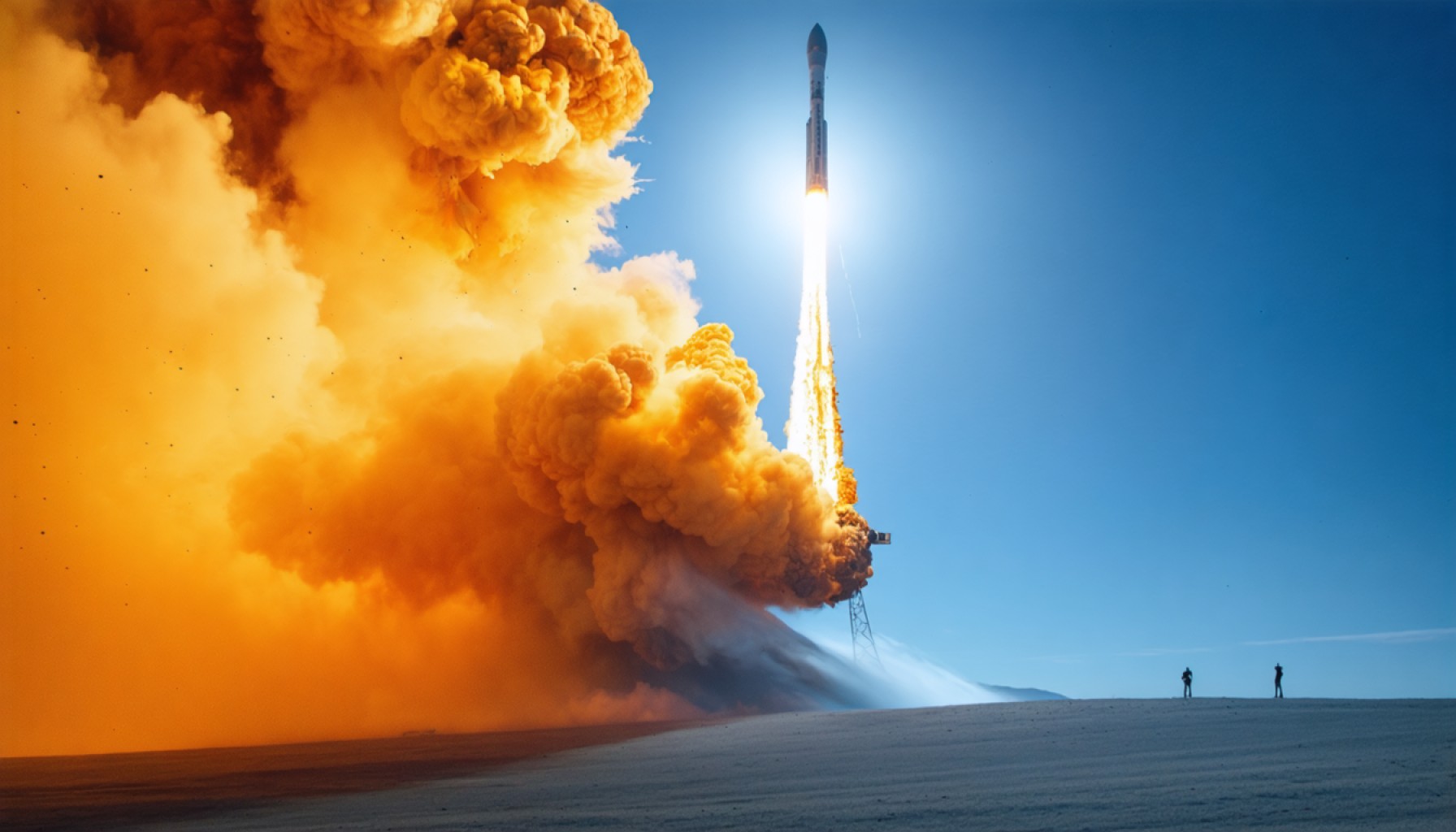
- SpaceX prepares to launch 21 Starlink satellites from Launch Pad 39A at Cape Canaveral, aiming to improve global internet access.
- The Falcon 9 rocket takes off at 9:15 p.m. EDT, following a southeast trajectory, with a planned booster landing on the drone ship A Shortfall of Gravitas in the Atlantic.
- Starlink’s mission is to deliver high-speed internet to remote areas, reducing the digital divide worldwide.
- Launch delays highlight the challenges of space travel and human perseverance in overcoming obstacles.
- The Starlink project promises significant societal impacts in education, communication, and innovation through enhanced connectivity.
- SpaceX’s initiative represents a crucial step toward a more interconnected world, overcoming digital isolation.
As the sun dips below the horizon at Cape Canaveral, another chapter unfolds at Launch Pad 39A, where a Falcon 9 rocket stands ready to carve a path through the night sky. This time, SpaceX sets its sights on deploying 21 Starlink satellites, promising to revolutionize internet access worldwide. The mission encapsulates SpaceX’s unwavering ambition—bridging the digital divide by enveloping the globe in a web of high-speed internet.

Thundering toward the heavens at precisely 9:15 p.m. EDT, the Falcon 9’s journey embarks on a southeast trajectory, leaving no sonic booms over Central Florida to herald its departure. Instead, a quieter yet equally profound achievement awaits as the first-stage booster seeks a landing on the Atlantic’s restless expanse—a rendezvous with the ever-reliable drone ship, A Shortfall of Gravitas.
Each satellite carried within this sleek metallic vessel forms a vital cog in the Starlink constellation, engineered to deliver high-speed internet to the most isolated corners of our planet. This vision, once speculative, now inches closer to becoming a tangible reality. Yet the path to deployment is not devoid of hurdles—a recent scrub demonstrates the unpredictability of each launch attempt, highlighting human perseverance in the face of elemental caprice.
As SpaceX orchestrates this celestial symphony, eyes remain fixed on the night sky and its promise of unprecedented connectivity. The implication of such technological triumph is vast, heralding potential societal shifts in education, communication, and innovation.
Reader, be mindful of this unfolding era where the boundaries of digital isolation begin to dissolve. SpaceX’s commitment to Starlink epitomizes humanity’s relentless quest for progress—where no corner of the Earth is too remote for connection. As Falcon 9 ascends tonight, count it as a monumental step in our collective journey toward a more connected future.
Why SpaceX’s Starlink Launch is Paving the Way for Global Internet Dominance
Overview of Falcon 9 and Starlink Mission
The launch of SpaceX’s Falcon 9 rocket at Cape Canaveral is more than a routine event; it marks a significant chapter in the ongoing saga of the Starlink project. Designed to deploy an additional 21 Starlink satellites, this mission is aimed at reinforcing SpaceX’s transformative vision of providing global high-speed internet access through a massive constellation of small satellites. By bridging the digital divide, SpaceX aspires to connect even the most isolated regions of our planet, potentially revolutionizing global communication, education, and technology sectors.
Key Features and Technology
– Falcon 9 Rocket: Known for its reusable design, the Falcon 9 has swiftly become the workhorse of SpaceX’s launch fleet. Its first-stage booster, returning via controlled descent to the drone ship “A Shortfall of Gravitas,” underscores SpaceX’s commitment to sustainability and cost-effective space travel.
– Starlink Satellites: Each satellite in the Starlink constellation is equipped with advanced antennas and a solar array, enabling coverage to remote locations and providing internet speeds comparable to standard broadband services.
Addressing the Biggest Questions
How Does Starlink Benefit Global Internet Access?
Starlink has the potential to offer high-speed internet to underserved and remote areas, which traditionally suffer from poor connectivity options. This could mean significant educational and economic improvements as communities gain access to the digital world’s resources.
What Are the Challenges and Limitations?
While promising, the Starlink initiative faces challenges such as regulatory hurdles, space debris concerns, and the need for sizable ground infrastructure to manage and distribute signals. Moreover, questions about the environmental impact of launching thousands of satellites into orbit persist.
Pros and Cons of Starlink Internet
Pros
– Broadband speeds in remote areas
– Potentially cost-competitive with terrestrial internet infrastructure
– No need for extensive ground-based infrastructure
Cons
– Initial setup costs for users
– Latency challenges compared to terrestrial internet
– Astronomical community concerns over increased “light pollution” in the night sky
Real-World Applications and Trends
Starlink’s internet service can greatly benefit disaster-hit areas where traditional infrastructure fails, assist maritime and aviation sectors with constant connectivity, and empower remote work and digital learning environments. The trend toward satellite internet is growing, with competition from companies like Amazon’s Project Kuiper and OneWeb enriching the market landscape.
Actionable Recommendations
1. Stay Informed: Follow updates from SpaceX and other players in satellite internet to make informed decisions on potential services.
2. Evaluate Alternatives: Compare Starlink with other internet providers in your region for the best service and pricing.
3. Consider Pre-Ordering: If you live in a remote area, consider pre-ordering Starlink to ensure early access as service expands.
For more information on SpaceX and its mission to provide global internet coverage, visit SpaceX.
Conclusion
As the Falcon 9 soars and adds new satellites to the Starlink constellation, it is clear that the world is on the brink of a connectivity revolution. While there are obstacles to overcome, the promise of universal internet access could drive significant societal advantages and redefine our interaction with technology. Keep an eye on SpaceX’s progress as it endeavors to make this ambitious vision a reality.



